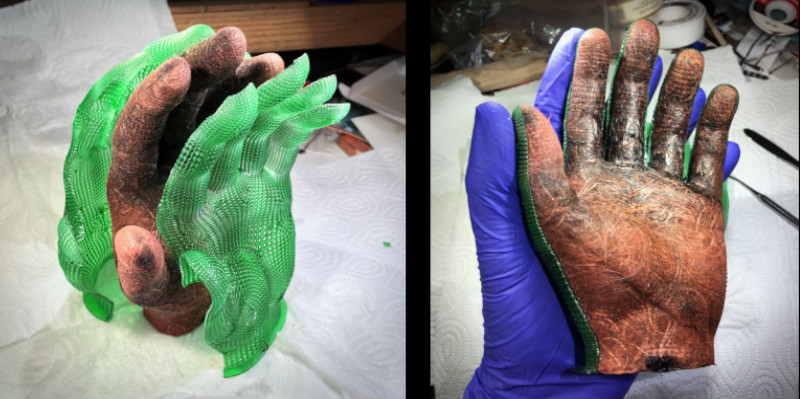Typically, electroplating is used to put coatings of one metal upon another, often for reasons of corrosion protection or to reduce wear. However, other conductive materials can be electroplated, as demonstrated by [Michaɫ Baran].
Finer details are sparse, but [Michaɫ’s] images show the basic concept behind producing a composite metal material hand sculpture. The initial steps involve 3D printing a perforated plastic shell of a hand, and stuffing it with carbon fibers. It appears some kind of plastic balls are also used in order to help fill out the space inside the hand mold.
Then, it’s a simple matter of dunking the plastic hand in a solution for what appears to be copper electroplating, with the carbon fiber hooked up as one of the electrodes. The carbon fibers are then knitted together by the copper attached by the electroplating process. The mold can then be cut away, and the plastic filling removed, and a metal composite hand is all that’s left.
[Michaɫ] has experimented with other forms too, but the basic concept is that these conductive fibers can readily be stuffed into molds or held in various shapes, and then coated with metal. We’d love to see the results more closely to determine the strength and usefulness of the material.
Similar techniques can be used to strengthen 3D printed parts, too. If you’ve got your own ideas on how to best use this technique, sound off below. If you’ve already done it, though, do drop us a line!
[Thanks to Krzysztof for the tip]
















Interesting idea. I worked with metalizing carbon fiber structures in the 80s and 90s at Boeing. Unfortunately most of it was cured epoxy and prepreg. The bare fiber was difficult to get from the manufacturers as they were struggling to produce.
That was my first thought. Where does one get loose carbon fibres like he shows?
Do you just shred carbon fibre cloth?
You buy CF in rolls. Look for carbon fiber roving.
Fibers from new roving can have problems, Michał said he used fibers from recycling (pirolysis). They would probably have rougher surface, which can help with coating.
You are right! Often carbon fibers are coated and therefore do not conduct electricity. I used recycled fibers, they were clean, pyrolysis treated. Carbon fiber felt works good, too.
You can electroplate onto just about any conductive surface. So the trick then becomes how do you make surfaces conductive. According to my electrochemistry professor, they make plated baby shoes and plated leaves by coating them with graphite. Then you just hook them up to the negative electrode with the positive electrode made of copper and dunk them into copper sulfate. You use low currents at first to establish a coating then increase until you’ve got the copper plate you want. As always, areas where the two electrodes are closest plate the most. You can get more uniform plating if you use cyanide based solutions but that’s another longer story . I’ve never tried this but that’s what we were taught.
Commercially no. Usually you use a catalyst laquer that triggers deposition of a thin layer of electroless copper. Then you can electroplate copper and nickel onto that. This is the same as how the pth holes in pcbs are done.
it is done on yacht from 5-10yrs … i dont get it what is new ?
I was looking for such information. Please give examples, I will be grateful!
This looks fantastic. The idea of stitching/binding together conductive carbon fibers with copper into abstract shapes using hobbyist-accessible equipment is wild.
Yes! You feel it well! This method is just as good for creating works of art as satellites :)
Now do this with monel or inconel or one of the other supermetals used in jet engines.
The only thing special about inconel is the price and strength at high temperature. If you’re not going to high temperatures, there’s usually a steel with a coating that’s stronger and much cheaper.
Supermetals are typically nickel based. Nickel can be electrodeposited, the challenge would be the placing other alloying elements in the precise ratios, especially for complex geometries.
Can you use steel wool instead of carbon fibers? Would be cheaper… How strong is your material? Does it break/delaminate easily?
The composite is as strong as you wish. In this case, you add metal so you get metal things but you decide about the specific weight of this object, and thus its durability. So it all starts with identifying the functions. This dictates the shape and density of the object, Btw, it can vary in different areas.
Until now, we have not had such possibilities of enforcing our will on material objects. 3d print is just making mockups of objects. The internal structure of the object is completely disturbed by layering. :(
For example, this tube cannot be damaged in hands:
https://www.tiktok.com/@michal_baran/video/6966803136891735301?lang=pl-PL&is_copy_url=1&is_from_webapp=v1
About a steel wool… It’s possible! The process will be more demanding, more chemistry etc.
Btw, I used to do experiments with cermets. An interesting effects (you can throw your cup at the walls), however, the method is very energy-consuming. That’s why I came up with Self-Created Metal Composites.
https://www.instagram.com/p/CUd2SD5I1lZ/
https://www.youtube.com/watch?v=G-PtnwtOR24